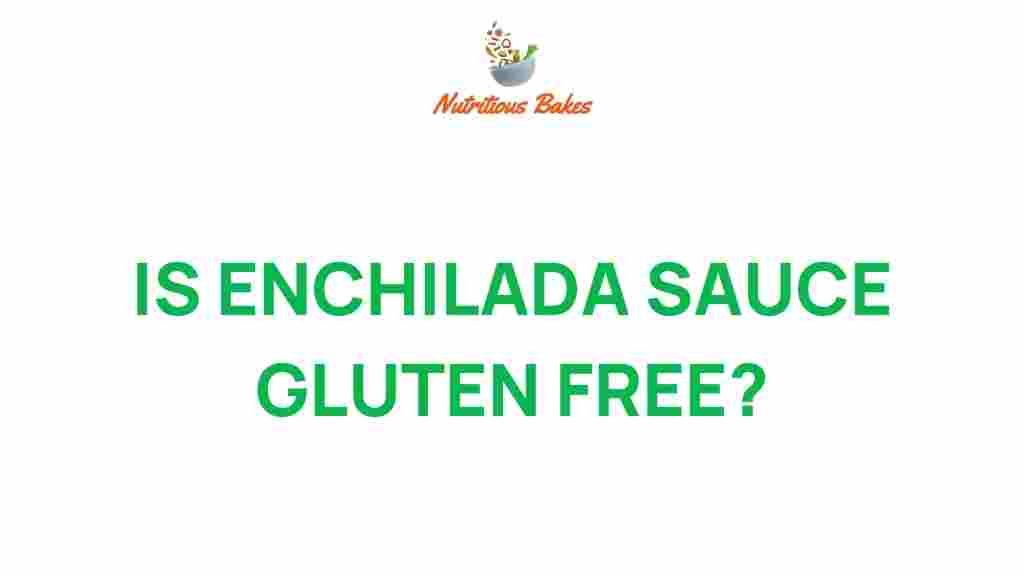Unraveling the Mystery: Is Enchilada Sauce Truly Gluten-Free?
When it comes to Mexican cuisine, few dishes are as beloved as enchiladas, and at the heart of this culinary delight is the often-debated enchilada sauce. For those with gluten sensitivities or celiac disease, the question arises: is enchilada sauce truly gluten-free? In this article, we will delve into the ingredients, cooking methods, and food safety practices surrounding enchilada sauce, providing you with all the information you need to enjoy this flavorful dish safely.
Understanding Gluten and Dietary Restrictions
Gluten is a protein found in wheat, barley, and rye. It can be problematic for individuals with celiac disease or gluten intolerance, leading to various health issues. Therefore, understanding ingredients is crucial for anyone adhering to a gluten-free diet. This is especially true in Mexican cuisine, where sauces and seasonings can often contain hidden gluten sources.
What is Enchilada Sauce?
Enchilada sauce is a rich, flavorful sauce traditionally used in Mexican cuisine to envelop enchiladas and other dishes. It usually consists of a base of tomatoes, chili peppers, and various spices. While many homemade versions are naturally gluten-free, pre-packaged sauces may contain gluten. Thus, checking labels is essential to ensure safety.
Common Ingredients in Enchilada Sauce
Enchilada sauce can vary in its ingredients depending on the recipe and the region of Mexico it originates from. Here are some common components:
- Tomatoes: Fresh, canned, or tomato paste are often used.
- Chili Peppers: Various types like ancho, guajillo, or chipotle add heat and flavor.
- Spices: Cumin, garlic powder, onion powder, and oregano are frequently included.
- Broth: Chicken, vegetable, or beef broth can enhance the flavor.
- Thickening Agents: Some recipes may use flour or cornstarch, which can introduce gluten.
Is Store-Bought Enchilada Sauce Gluten-Free?
Many brands of store-bought enchilada sauce are gluten-free, but not all. To ensure you’re choosing a safe option, follow these tips:
- Read Labels: Always check the ingredient list for any gluten-containing ingredients.
- Look for Certifications: Gluten-free certifications from recognized organizations can provide peace of mind.
- Contact Manufacturers: If in doubt, reach out to the company for clarification on their products.
Homemade Enchilada Sauce: A Gluten-Free Option
Making your own enchilada sauce is an excellent way to control the ingredients, ensuring that it is gluten-free. Here’s a simple recipe to get you started:
Ingredients:
- 2 tablespoons olive oil
- 1 medium onion, finely chopped
- 3 cloves garlic, minced
- 1 can (15 ounces) tomato sauce
- 2-3 dried chili peppers (like ancho or guajillo), rehydrated
- 1 teaspoon cumin
- 1 teaspoon oregano
- 1 cup vegetable or chicken broth
- Salt and pepper to taste
Instructions:
- In a skillet, heat olive oil over medium heat. Add the chopped onion and sauté until translucent.
- Add minced garlic and cook for an additional minute, being careful not to burn it.
- In a blender, combine the sautéed onions and garlic, tomato sauce, rehydrated chili peppers, cumin, and oregano. Blend until smooth.
- Pour the mixture back into the skillet, add the broth, and stir to combine. Season with salt and pepper.
- Simmer for about 10-15 minutes until the sauce thickens. Adjust seasoning as necessary.
This homemade enchilada sauce is both delicious and gluten-free, perfect for your next Mexican meal!
Food Safety and Cross-Contamination
For those with dietary restrictions, food safety is paramount. Here are some tips to prevent cross-contamination:
- Separate Cooking Equipment: Use separate cutting boards and utensils for gluten-containing and gluten-free foods.
- Clean Surfaces: Ensure all surfaces are thoroughly cleaned before preparing gluten-free meals.
- Store Properly: Keep gluten-free sauces and ingredients in separate containers to avoid mix-ups.
Troubleshooting Common Issues with Enchilada Sauce
Even the best cooks can run into issues when making enchilada sauce. Here are some common problems and their solutions:
- Too Spicy: If the sauce is too hot, add a bit of sugar or honey to balance the flavors.
- Too Thick: Add a little more broth or water to reach your desired consistency.
- Lacking Flavor: Adjust seasoning with more salt, pepper, or spices as needed.
Delicious Recipes Using Enchilada Sauce
Enchilada sauce can be used in various recipes beyond traditional enchiladas. Here are some ideas:
- Enchilada Casserole: Layer tortillas, filling, and enchilada sauce for a hearty dish.
- Mexican Rice Bowl: Use enchilada sauce as a topping for rice bowls with beans and vegetables.
- Stuffed Peppers: Mix enchilada sauce with quinoa, beans, and cheese, then stuff into bell peppers.
These recipes highlight the versatility of enchilada sauce in Mexican cuisine while accommodating gluten-free dietary restrictions.
Conclusion
In conclusion, enchilada sauce can be a gluten-free delight, provided you are mindful of the ingredients and preparation methods. Whether you opt for a store-bought version or create your own at home, understanding the components is key to ensuring your dish is safe and enjoyable. With the right knowledge, you can savor the rich flavors of enchilada sauce without compromising your dietary restrictions.
For more recipes and cooking tips related to gluten-free options, check out our Gluten-Free Cooking Guide. And remember, always prioritize food safety in your kitchen to enjoy delicious meals without worry!
Happy cooking!
This article is in the category Ingredients and created by NutritiousBakes Team
